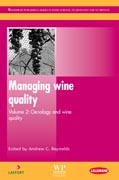
Many aspects of both grape production and winemaking influence wine sensory properties and stability. Progress in research helps to elucidate the scientific basis of quality variation in wine and suggest changes in viticulture and oenology practices. The two volumes of Managing wine quality review developmentsof importance to wine producers, researchers, and students. The focus is on recent studies, advanced methods and likely future technologies. Part one of the second volume Oenology and wine quality opens with chapters reviewing the impact of different winemaking technologies on quality. Topics covered include yeast and fermentation management, enzymes, ageing on lees, new directions in stabilisation, clarification and fining of white wines and alternatives to corkin wine bottle closures. Managing wine sensory quality is a major focus of Part two. Authors consider issues such as cork taint, nonenzymatic oxidation andthe impact of ageing on wine flavour deterioration. The volume concludes withchapters on the management of the quality of ice wines and sparkling wines. With authoritative contributions from experts across the world’s winemaking regions, Managing wine quality is an essential reference for all those involved in viticulture and oenology wanting to explore new methods, understand different approaches and refine existing practices. Dr. Andrew G. Reynolds is Professor of Viticulture at the Cool Climate Oenology and Viticulture Institute, BrockUniversity, Canada. His career has included a position as Research Scientist for Agriculture Canada in British Columbia and, since 1997, a faculty positionat Brock University. He is well known for his research into canopy management, the impacts of site and soil on flavour, irrigation and water relations, geomatics and the use of GPS/GIS and remote sensing for studying terroir. INDICE: Part 1 Wine making technologies and wine quality: Yeast and fermentation management for improved wine quality; Metabolic engineering of wine yeast and advances in yeast selection methods for improved wine quality; Effects of malolactic fermentation on wine quality; Enzymes and wine quality; Membraneand other techniques for the management of wine composition; Ageing on lees (sur lies) and the use of speciality inactive yeasts during wine fermentation; New directions in stabilisation, clarification and fining of white wines; Microoxygenation, oak alternatives and added tannins and wine quality; Alternatives to cork in wine bottle closures; Current issues in organic winemaking: consumer expectations, producer attitudes and oenological innovation. Part 2 Managing wine sensory quality: Yeast selection for wine flavour modulation; Brettanomyces/Dekkera off flavours and other wine faults associated with microbial spoilage; Reducing cork taint in wine; Ladybug (Coccinellidae) taint in wine; Understanding and controlling non-enzymatic wine oxidation; Ageing and flavour deterioration in wine; Biogenic amines and the winemaking process; Managing the quality of icewines; Managing the quality of sparkling wines; Extraction technologies and wine quality.
- ISBN: 978-1-84569-798-3
- Editorial: Woodhead
- Encuadernacion: Cartoné
- Páginas: 672
- Fecha Publicación: 01/08/2010
- Nº Volúmenes: 1
- Idioma: Inglés
